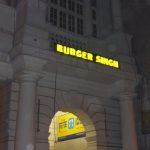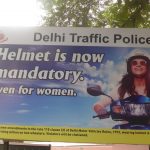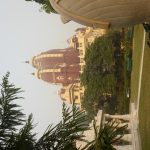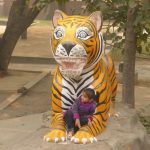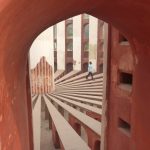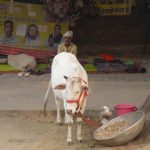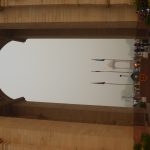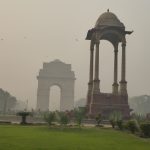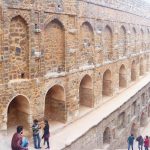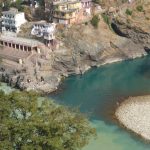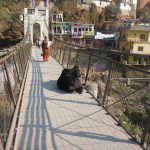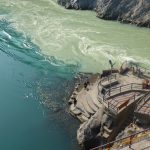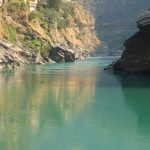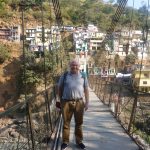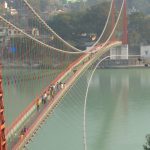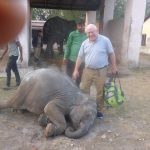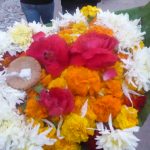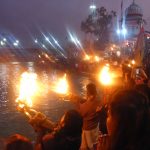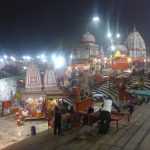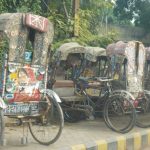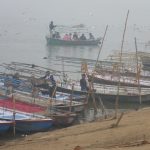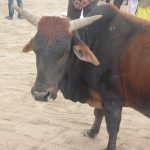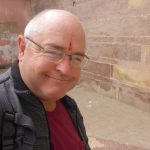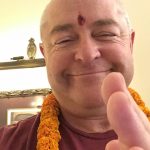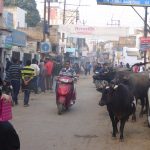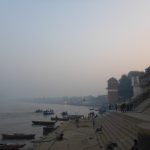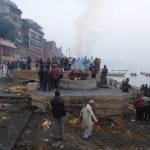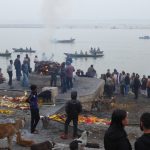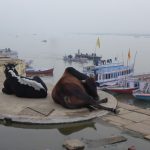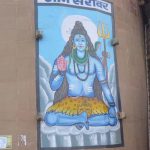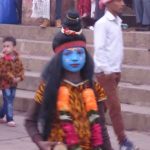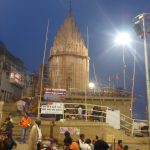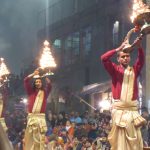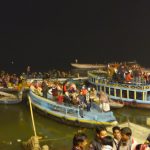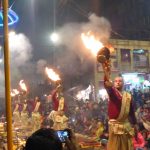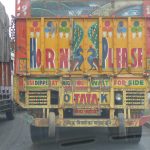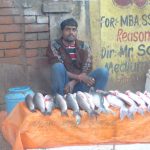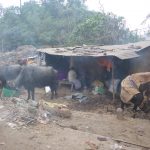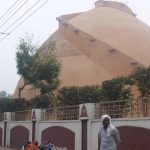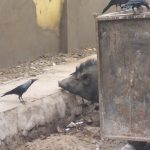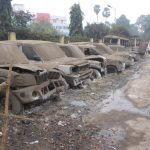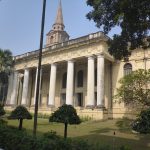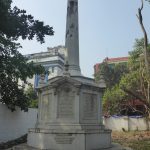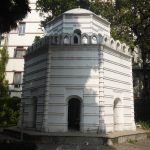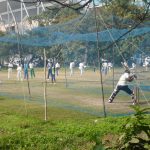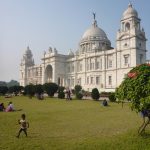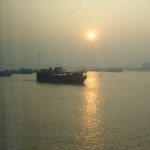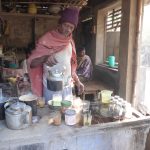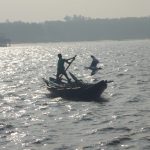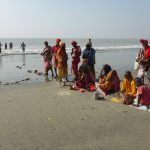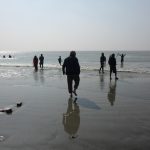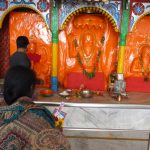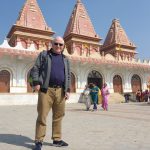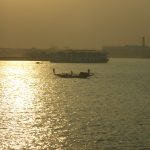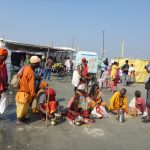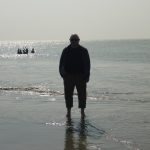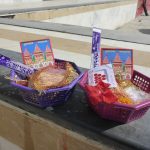Arabian Sea 3rd December 2016
I just had a month or so on H’s ship, cruising from Valletta to Mumbai. Stopping at various places in Greece – Katakolon, Piraeus, Volos/Meteora, Santorini, Rhodes and Heraklion. Then through the Suez Canal to Aqaba. Then into the Arabian Sea and the Persian Gulf to Salalah and Muscat, Abu Dhabi and Dubai.
We will be arriving in Mumbai tomorrow and it is definitely time for me to get off and do some real man traveling all by myself. The plan now is to trace the route of the Ganges River from its source in the Himalayas to the sea in the Bay of Bengal to the south of Calcutta. I have a couple of weeks to play with but it is a trek of 2500 km and I have no idea if it is possible to see it all. If I use a boat at all it will only be for short legs. Much of the trip will be by plane or train. Indian Railways will be a nightmare. I’ve been waiting ages for them to register me to make online bookings. So far I’ve not been able to make any reservations so I might be travelling 5th Class on the roof.
Mumbai 4th December 2016
Arrived in the port of Mumbai this afternoon and H and I went ashore to see Unglaubliche India.
The memsahib takes a very firm line with anyone we have dealings with, such as taxi drivers, and attempts to rip them off with as much effort as they use trying to rip us off. All not very relaxing. The first taxi stop was a ladies emporium across town and the memsahib emerged with an impressive sari and much Indian bling. The next problem was that there is a lot of post-purchase work involved with a sari, such as making blouses and pleats, and we had to immerse ourselves in the teeming slums of Mumbai to find a recommended tailors which we found down an dingy alley with swastikas (Hindu supposedly) on the shop front. They agreed to do a staggering amount of work in a few hours for not much money while we went off to the swanky Taj Mahal Palace Hotel for sundowners of G and T (Bombay Sapphire, naturally) and samosas.
Our taxi driver nagged us into visiting this other sari place which I came close to refusing to enter as it was upstairs in a nasty building that looked like the only thing holding it together was the dirt on the walls. Two more saris joined the collection but these were pret a porter and didn’t need extra work. See earlier blogs about Fiji !!
After collecting the tailoring work we went back to the Taj Mahal Palace Hotel for a curry dinner with the memsahib sporting her new sari. In the hotel which had literally hundreds of women wandering about also wearing upmarket saris, the memsahib had more than her fair share of compliments.
Delhi 5th December 2016
An interesting development from the sari wearing by H yesterday. After taking the new blouse off she had large parts of her stained blue. Looked like a Smurf. I was amused anyway.
Got a flight from Mumbai to Delhi today leaving the memsahib to take the big ship south to Goa.
Money changing is turning out to be a problem. A tour guide taking ship people to Agra tried to arrange something for me with his friend, but this friend didn’t turn up. There were massive lines at all ATM’s in the airport and it turns out there are massive lines all over India with people trying to get notes that are not 500 or 1000 rupees. The only legal stuff now seems to be 100 rupees which is worth a bit over a euro and 2000 rupees worth about 30 euros.
I got a scary pre-paid taxi from the airport to the hotel at Connaught Place. Honking the horn continuously while trying to run other cars off the road and dodging monkeys and pigs seems to be the way it is done. Much like it is in Karachi except there are no pigs there. The driver couldn’t find the hotel which was not surprising as the hotel was a walk-up to the 2nd floor of a scruffy building with no signage on it. I tracked it down eventually on foot. It’s a very dilapidated hotel with a broken door lock and dangerous looking electrical arrangements but it has Wi-Fi.
Delhi 6th December 2016
I was woken gently this morning by somebody hammering nails into my hotel room door. I’m not exaggerating. A short while later a furtive Indian chap asked me if I had ordered tea. As I hadn’t I sent him away with a metaphorical boot up the bum. It turned out he had really come to take my breakfast order. They have no breakfast room in the hotel, so they do a sort of room service. My guess is they cooked my omelette over a dried-cow-dung fire in the street.
Fortified by breakfast, a cold-water shower and a Bollywood movie on the TV, I ventured out into the throbbing heart of the city. When I was last in Delhi, in 1978 with Tim, John and Jeff, I thought it couldn’t be possible for a city to become any more squalid, wretched and noisy. I was young and foolish, and it is possible. A typical 100 metres of walking in Dehli involves stepping over four or five beggars and telling three or four tuk-tuk drivers that just because they’ve found out which country you’ve come from doesn’t mean they are going to be hired all day. On top of that, any kind of slowing down from a purposeful walk and looking up from the ground will immediately (I tested it and got an average of 2 seconds) get somebody telling you the street address where you are stood and that they don’t want any money. Sometimes this is true but mostly it’s not and violence or money is the only way to dislodge them. Sad really.
For those who don’t know, I have a problem with my voice these days which means I can only produce a quiet stage whisper even when shouting. Having to make myself quietly understood to uninvited people who have idiosyncratic English, in a background din of traffic noise and continuous horn honking, is not good karma.
I retraced some of the places I’d been to before in ’78, the Jantar Mantar observatory; the YMCA on Jay Singh Marg and the Laxminarayan Temple. I couldn’t find the grocers shop at Connaught Place where we dismally failed to buy sensible provisions for a mountaineering expedition. The shop probably sells jeans now. I think packets of ‘Vesta Beef Curry’ were what we had in mind, but we ended up with a big sack of rice and some mysterious herbs and spices that eventually got donated to a village on the Tibetan border. These foodstuffs were sold to us in true Victorian style by somebody taking the order at a counter; somebody else going up a ladder for the stuff and somebody else writing out an invoice so you can pay the book keeper. All this while yet another shop assistant wraps your stuff up into fancy parcels. I have to say they have now dispensed with all this nonsense by simply not having grocery stores on Connaught Place at all.
I got to the India Gate as well which I had not seen before. It was a bit misty but it’s a very striking WW1 monument. Well done, Mr. Lutyens! It was a long walk so you can imagine how many tuk-tuk drivers had to be let down ever so gently. I got to the India Gate on the Rajpath by pushing my way through a big political demonstration on the Janpath. It seemed to be a call to join the fight against rioting. Made sense at the time.
I did get a tuk-tuk eventually as my feet were sore and went to “Burger Singh” for a veggie dinner. I then spent a couple of hours trying to shake off a self-appointed guide and road-crossing assistant. I did let him take me to half a dozen back-alley money changers, but nobody had any rupee notes to sell even at inflated rates. I still had to pay my guide to go away. Not so well done, Mr Modi! Your dream of a cashless society shouldn’t inconvenience tourists who bring foreign currency into the country and don’t personally hide it from the Indian taxman. Not being able to change money wouldn’t be so bad if the ATMs were accessible but there is no way I’m standing in line all day. It has become an instant tradition here for permanent lines around the block to form at all ATMs and when one of the banks inevitably runs out of cash a huge roar erupts from the linear crowd. I predict even more rioting. I will join in.
Haridwar, 7th December 2016
This morning I had an omelette, toast and tea delivered to my room as a wake-up call. I didn’t ask for a call or breakfast but this is India after all.
When I checked out, the hotel phoned for a taxi to take me to the airport but they said sorry but there was nothing available. So I went out into the street and selected one of the five million or so taxis cruising past that were not quite so busy.
The departure area in the airport was really crowded. After an hour I managed to get a seat where I could see both the advertised gate and the information screen. Both of which I watched like a hawk anticipating problems. I could have been in the business lounge, but I thought being closer to the gate would be safer. On the information board there was just “Delayed”, an increasing ETD and a gate number. Then almost two hours after the original departure time the “Delayed” flipped to “Departed”. Oh oh!
Another flight, same airline, same destination, was boarding just then. I spoke to the check-in guy and he said “It’s the same flight, go, go”. He scanned my ticket and I was on the shuttle bus to the plane. As I was just about to actually step on to the plane, I thought this can’t be right. What’s my seat number? So I asked. It turned out my original plane had left from some other gate without them ever feeling the need to update their information and now this plane was completely full. My first hissy fit of the day was under the belly of a plane on the tarmac at Indira Gandhi International Airport.
I got a new ticket for a later flight. Went through the intimidating but useless security process one more time and went to the business lounge for a curry and a beer.
When I arrived at Dehadrun airport I knew I had no onward transport and I needed to go some distance to Haridwar. I had tried to rent a car by email several times but got no sensible replies. There was no car rental-desk, so I got a taxi using up a lot of my now precious rupees. The drive was hellish with bikes, trucks, cars and tuk-tuk’s all screaming along nose-to-tail at maximum speed and jostling for overtaking space on rough roads through dusty mountain villages. I was very very glad not to be driving myself. Even my driver, who seemed to be able to squeeze though any gap, had to stop about a quarter of a mile from my hotel as the streets became narrower than the car. I had to take to a cycle-rickshaw for the final leg. From what I could see in the dark the town of Haridwar was the usual ramshackle mess but the Haveli Hari Ganga hotel turned out to be really nice. There was a sitar player in the lobby and they gave me some Hindu beads and some hot welcome soup.
The Ganges runs down one edge of the building. At this point the river is very fast flowing and about 100 metres wide.
I had something off a leaf plate and a nice thali in the restaurant for dinner but without any meat or alcohol. Can’t get that stuff here at all. I’ll survive.
Haridwar, Uttarakhand, India. 8th December 2016
Had a look at the Ganges first thing in daylight from the hotel terrace. Heaps of marigolds and other vegetable offerings to Ganga Maa were floating past at a fair clip. Had breakfast in the Haveli Hari Ganga but veggie Indian breakfasts take some getting used to.
Having decided that it would be suicidal to try and drive myself here, I got the cycle rickshaw wallah to take me to rent a car and driver for the day. We drove off into the mountains through Haridwar and Rishikesh on to Devprayag at the start of the River Ganges. Sounds easy enough but it was a nail-biting ride.
Every few minutes there is something happening on the road in front that is either utterly illegal in Europe and/or dangerous and inconsiderate enough to cause serious road-rage. Here it is seen as just normal polite driving. A bit scary when going off the road can mean a sudden stop about 500 metres straight down. It’s not possible to fret about all these incidents all the time and I’ve found that after a while a kind of fatalism kicks in which is probably what is at the heart of Hinduism. The honking still gets on my nerves, but I have a theory that it is a form of Morse code which can be used to communicate around blind bends and from blind spots about how much you are indifferent to causing a collision. It may also be a kind of bat-squeak-like sonar which allows bumper to bumper driving without the need to look.
Aside from the traffic and the state of the roads the drive was very interesting with spectacular scenery and all kinds of wildlife like brown rhesus macaques and grey langurs fighting and sleeping and orange Hari Krishna trekking. Rishikesh was a colourful place with pink temples and ashrams built up on either side of the wide river. The roads were jammed with big blue tuk-tuks, brightly painted trucks and wedding cars decked out with strings of marigolds. Unfortunately, I had to give the ruined ashram, where the Beatles hung out in 1968, as miss as it was on the wrong side of the river.
After a few hours driving we reached Devprayag. This is a tiny little place perched on rocks at the confluence of two fast flowing rivers that come out of glaciers further up into the Himalayas than I had time or energy to reach. At the point these two rivers, the Bhagirathi and the Alaknanda, join the river becomes Ganga. A complicated Hindu thing where the goddess Ganga and the Ganges River are the same entity. So, the quest to the mouth of the river begins! I dipped a toe in.
On the way back we stopped off at the Rajaji National Park elephant orphanage. I suspect it wasn’t a tourist spot as there were keep-out signs. There was a baby elephant there that really wanted a cuddle. It was a pity that it felt like stroking a doormat.
In the early evening I went to Har Ki Pauri in Haridar with an American couple I met in the hotel, who were there for a friend’s wedding. Har Ki Pauri is where they have a big Hindu river-worshipping ceremony every day called Ganga Aarti. You buy a “flower pot” for 20 rupees (about 30 cents) which is a leaf basket filled with red and gold flowers and a candle in it. As the sun sets there are about a thousand people all singing, banging drums and waving stuff on fire. Then comes time to get a blessing and launch your own burning basket into the Ganga. It was gone in seconds, but I expect to see it again further down the river.
Delhi, 9th December 2016
My next Ganges stop is Allahabad but there is no direct flight there from Dehadrun and I still don’t have an official permit yet to make online train reservations. The trains are almost always fully booked weeks in advance and I don’t think I’ve got the immune system for an unreserved sleeper compartment in Untouchables class.
It’s a bit off route but I’ve returned to Delhi by air for an overnight.
While I was waiting at Dehadrun Airport, the President of India landed in his Airforce One plane to check up on how my trip was going. Which was nice. He had to quickly leave again by helicopter before we could chat properly as he had an appointment or something. Bon voyage Mr Mukherjee and thanks for not delaying my flight too much.
Allahabad, Uttar Pradesh, 10th December 2016
Flew to Allahabad from Delhi this morning in a little regional Air India plane. Allahabad is an important location on the Ganges for Hindu’s. It is the confluence of the Ganges and the Yamuna rivers and a location for one of the massive Kumbh Mela gatherings every 12 years. The place is described as
the confluence of three rivers but one river is apparently invisible. You couldn’t make this stuff up!
Yesterday, I thought Delhi was a chaotic mess but I’ve mentally upgraded the place to ‘orderly’ now that I can compare it to a provincial city. It’s hard to imagine how people can live for very long in these conditions. Maybe they don’t.
All the senses get a good battering when travelling along these lumpy mean streets. The air is filled with windblown dust, smoke from cooking fires, and diesel engine fumes and smells that change rapidly from open sewer to fragrant spices and back again. Visually, the streets are a riot with bright
colours applied enthusiastically to everything including elephants. The sound landscape is dominated by the usual horn-honking with an underlying rumble of revving engines, Indian music and shouting. My hotel room here in Allahabad has an unfortunately close view of the rail station and
marshalling yards and even the trains are honking constantly. Are they really signalling that they are about to swerve in front of another train?
I stepped out of my hotel before it got dark to take in some local atmosphere and to check out the train station. I had to quickly retreat to get away from the beggars following me around tugging at my clothes, and the circling swarms of cycle-rickshaw wallahs. It must be a little easier for
travelling Indians who don’t have “ask me for money” written on their foreheads like us Europeans.
Even though I was being hassled, I observed the Unreserved rail ticket office for a few minutes. It had hundreds of dhoti-clad men there, all shouting and trying to stick their arms through the ticket booth windows. I’m giving up my plan to travel on by train and, even though it will put a
hole in my remaining rupees, I’m going to get a car and driver-wallah to look around Allahabad in the morning and drive on to Varanasi.
Varanasi, Uttar Pradesh, 11th December 2016
I had a look around Allahabad in the misty morning. Allahabad didn’t look to be too wealthy a city as cycle rickshaws make up the bulk of the transportation. Tuk-tuks looked to be for special occasions and taxis only for foreigners.
My taxi driver took me to see some streets where some un-blessed caste specializes in making cow-dung patties. He seemed very proud of it.
The next stop was the vast sandbank at the junction of the Ganges and Yamuna rivers. There were hundreds of people there, either camped out in rough shelters or setting out religious trinket stalls. At the major festivals, there can be several million people (literally) hanging out on the sand. A rowing boat to go out into the huge river to the place where the different coloured streams meet seemed popular, but it was foggy and time was pressing.
I wanted a look around the Alahabad Fort but it was apparently being used by the Indian Army. In the wall of the fort, in what looked like an old dungeon, I saw an entrance to a temple. I went in for a quick look around, but it seemed to be set up to repeatedly extract small sums of money from visitors. Or just me, as I was the only visitor. There was a parade of priests dabbing red marks on my head and demanding offerings to a whole pantheon of tackily painted idols. I was feeling a bit queasy from the incense, and staring into my wallet watching my rupees vanish, so after the fifth blessing I beat a hasty retreat ignoring the calls that there were some poor gods who were still waiting for their money.
Next was a wild drive for a few hours along the Grand Trunk Road through rural Uttar Pradesh to the city of Varanasi.
The streets of Varanasi are not really streets. Just narrow spaces between rough buildings made up of potholes, people and rubbish. Also, there are cows everywhere blocking the way but they get away with whatever they want with their ‘I’m so sexy’ eyes.
I spotted an ATM near my hotel with only about 20 people and a water buffalo (it’s true) standing in line. So, I managed to get a little tipping money. 2,000 rupees (€28) is the max they allow from ATMs these days.
As sunset approached, I wandered along the famous ghats for a mile or two. Ghats are steps leading down to the river. They come in two types; bathing and burning. Self-explanatory really. It’s a very strange place. I watched a few cremations at one of the burning ghats but they must have been rich people as there was enough wood to do a proper job.
I did touch the Ganges at one bathing ghat but I confess to using hand disinfectant straight away as a lot of bodies are tossed into the river only slightly toasted.
At sunset, the Ganga Aarti ceremonies start up with much singing, bell ringing and fire. Nowhere looked safe to eat so after the ceremony I went back to my hotel for a mutton biryani. I was the only diner and had a sitar and drums trio to myself with them playing a medley of Christmas favourites. Which was nice.
Patna, Bihar 12th December 2016
I got a taxi to my next Ganges stop at Patna. It cost 6,000 rupees (€84) which wiped me out of all my local money. I was probably ripped off but on the other hand it was 250 kms, door-to-door and 8 hours on the road through some amazingly strange and challenging villages and countryside.
We hit the Grand Trunk Road again about 10:00 after battling through the nasty back streets of Varanasi.
Passing through the checkpoint on the Uttar Pradesh/Bihar border the level of poverty took a significant step down. The countryside was more agricultural which fortunately made it a little more pleasant to look at. Much of the Bihar agriculture seemed to be the gathering and carrying around on heads of a kind grass or reed. I guess it was cow and buffalo feed, but they also use it for making straw huts. Other activities were the gathering of sticks for fuel and lots of small-scale brickmaking. Good to see they have all the materials for three-little-pig houses before the big bad wolf comes. I saw some hand-threshing and winnowing of a grain crop, but it must have not been the season for other crops.
A typical out-of-village scene was people wrapped up in shawls, sitting on the ground, near a straw hut and tending a smoky fire. Children are usually nearby whacking water buffaloes with sticks. In the villages, and we must have passed through dozens, the street scene is more frenetic with miles of market stalls and workshops. The air across the whole region was smoky from countless fires. Take away anything running on petrol and the whole scene had a biblical look.
I arrived in Patna in the dark during what I hope was rush hour. Offline maps on a smart phone are so useful. I doubt my driver will ever find his way home. In the hotel, I had to fill in a form saying that I understood possession and consumption of alcohol in the State of Bihar is a punishable offence. It will be good for their tourist industry I expect.
Kolkata, West Bengal 13th December 2016
Patna. Least said, soonest mended. Not recommended as a place to get a pre-dinner G&T.
Which is what I’m having now. In the bar on a floating hotel on the Hoogley River in Calcutta (same river different name). I arrived in the dark but it seems to be a good view from my cabin across the wide river to Howrah.
I’m looking out for the flower offering I set adrift in Haridwar a couple of thousand kilometres upstream. I don’t think I had my money’s worth.
Kolkata, West Bengal 14th December 2016
Had a day exploring the remains of British India in Calcutta.
In the morning smog I pushed my way on foot through tight streets of food vendors to get to the first item on my list of stuff to see. While I would have loved to have sampled this Bengali street food, bitter experience has taught me to be a bit scared of it. Maybe later in the trip.
My first stop was St. John’s Church, built in 1787 and modelled after St. Martin–in-the-Fields in London, apparently.
The memorials inside the church are very descriptive, if sometimes a bit overblown, and give a vivid impression of what it was like to live and die, usually young, in the service of the East India Company and the British Raj.
Outside the church is the mausoleum for Job Charnock. It was he who in 1690 first set up shop here for the East India Company. Also, in the grounds is the re-located memorial to the victims of the Black Hole of Calcutta incident of 1756.
Moving on to my next item, I walked across the very large open space next to Fort William called the Maidan. Parts of this area are now given over to sports clubs and several cricket matches were in full swing. The prairie-like grassland that is not cricket-ground was covered in litter. A great deal of it. How this can happen, in a country where the cost of labour to keep it tidy would be so little, baffles me.
I walked on to the Victoria Memorial. A splendid cathedral-like building which was completed in 1921. It had some good exhibitions about important Brits and the history of Calcutta. All this walking was only possible as it’s winter here and it’s a very nice temperature of pollution. Other times of the year, it’s either heavy monsoon rain or blast-furnace heat. Even so, I got a big yellow taxi back to the hotel. Most cheap taxis here are battered yellow Ambassadors which makes the place look, at first glance, like 1940’s New York. There’s no AC in yellow taxis so those with deeper pockets, who prefer to be cool and not travel in a pile of rattling junk, get white taxis.
I watched the sun go down from my room. Clumps of vegetation and rubbish were moving quickly down river on the outgoing tide and bats were out feeding over the water.
Kolkata, West Bengal 15th December 2016
Had to get up horribly early to meet my car and driver to go to Gangasagar. Gangasagar is at the southern tip of an island in the estuary of the Hooghly River about 110km south of Kolkata. The place has big significance for Hindus and marks the end of the Ganga. The estuary is about 35km across at this point.
80kms south from Kolkata, the road ended, and I had to get a passenger ferry to Sagar Island. The crossing was a slow struggle for 3kms into a fast-flowing flood tide of murky water. The ferry was one of those that looks like the ones you see capsized on the TV with hundreds reported drowned. I could see only half a dozen life-belts hanging up. As there were a couple of hundred pilgrims and islanders on the ferry I guess the less well-fed ones wouldn’t have made it if there had been problems. I’d hired a guide in Kolkata for this leg as I found my Bengali to be a bit rusty. He was a young lad on his 24th birthday who had kittens on the ferry as he couldn’t swim and his pandit had earlier told him he would die in a river. He’d never been to Gangasagar before so there wasn’t much guiding but he was useful for negotiating for tea and transport. The next car took us the last 30kms down the island to the beach.
White folks like me were few and far between there. In fact there was only me so I got a lot of attention from the beggars. The sadhus that infest this kind of place are no better and usually expect a reward just for turning out in hi-visibility clothing. The main temple here is Kapli Muni which celebrates some mythical Hindu violence related to the origins of Ganga. I had some offerings of flowers blessed for the memsahib in memory of her mother and got an orange stripe on my forehead, called a tikli, in return. I was on my way to becoming a sadhu.
I had a paddle in the Bay of Bengal to complete my Ganges journey. Reaching the sea, to a stretch of water that I have sailed across before, somehow didn’t feel much like an ending. More like the start of something else.
Kolkata, West Bengal 16th December 2016
I decided to save visiting the Sundarbans tigers for another day as it’s in a very remote area and needs more time than I have to do properly. Instead I’ll be looking around Kolkata until Monday.
I changed hotels this morning to the nearby Oberoi Grand just to remind myself what a clean bathroom looks like. The contrast between the calm of this nice old colonial hotel and the noisy surrounding streets is extreme.
Just behind the hotel is the Hogg (or New) Market, also once nice and colonial, which gets my vote for being the dirtiest, most crowded and useless shopping experience ever. I know what bazaars and souks can be like and, trust me, the world would be a better place if this one got bulldozed into the river.
Kolkata, West Bengal 17th December 2016
I just hung around the hotel today reasonably convinced that I didn’t need the hassle from the touts outside the hotel’s big, guarded, gates.
I did ponder for a while though on the subject of why this country is like it is. India is dotted with some fantastical jewels of architectural splendour and natural beauty but for the most part they are set in a sea of grubbiness and economic mess.
My theory, for what it’s worth, is that all this is caused by the collective psyche of the nation being too heavily influenced by the belief in an eternal cycle of birth, life and death.
With this belief, social status is predetermined by what earlier incarnations did or did not do and it’s pointless doing anything about it because it can’t be changed. This lack of social mobility does nothing for the economic health of the country. Neither do touts. Future incarnations can have improved status by doing rituals and pilgrimages. This gets many temples built but also does nothing else for the economy.
Lower social status groups are there to deal with the mess because their earlier incarnations screwed up. The lowest social levels have nobody to pass the buck to but don’t have the energy or inclination to sweep or make bathrooms sparkly.
Voila! Poverty and squalor.
Dum Dum near Kolkata airport, West Bengal 18th December 2016
I checked out of the Oberoi Grand Hotel this morning after another failed attempt to find something to worth buying in the street markets. Boris Becker, tennis star of a long time ago, was stood next to me in the lobby. I was much too cool to ask for a selfie but a few Indian girls took the opportunity.
I’ve got a cheap hotel near the airport for tonight as I booked an early flight to Mumbai and didn’t want to get stuck in Kolkata traffic. It wasn’t something I needed to have worried about as I just had an email from Air India saying I could sleep in a bit later if I wanted.
There’s a very loud concert of Indian music going on just a little way down the road. I went to have a look earlier and found an 20-odd piece band and singers, with an audience of about 50, on some wasteland. It might be something political or religious as there are speeches between songs but I couldn’t make sense of it. I left but I can hear that it’s still in full swing.
I might be going hungry this evening as the hotel restaurant looks closed and there is nothing to be had outside except cigarettes and dusty bags of chips from roadside stalls. One stall had some live chickens on sale earlier and I could regret not buying one.
